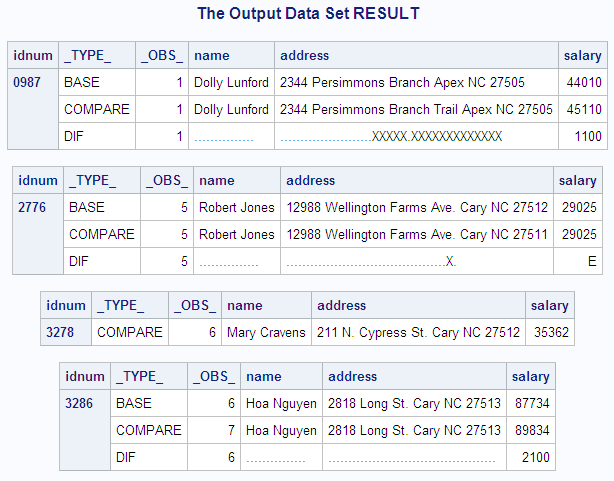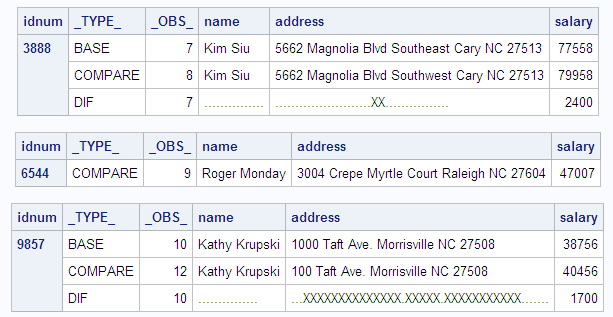COMPARE Procedure
- Syntax

- Overview
- Concepts
- Results
- Examples
 Producing a Complete Report of the DifferencesComparing Variables in Different Data SetsComparing a Variable Multiple TimesComparing Variables That Are in the Same Data SetComparing Observations with an ID VariableComparing Values of Observations Using an Output Data Set (OUT=)Creating an Output Data Set of Statistics (OUTSTATS=)
Producing a Complete Report of the DifferencesComparing Variables in Different Data SetsComparing a Variable Multiple TimesComparing Variables That Are in the Same Data SetComparing Observations with an ID VariableComparing Values of Observations Using an Output Data Set (OUT=)Creating an Output Data Set of Statistics (OUTSTATS=)
Example 6: Comparing Values of Observations Using an Output Data Set (OUT=)
| Features: |
|
| Other features: |
PRINT procedure |
| Data sets: | PROCLIB.EMP95 |
Details
This example creates
and prints an output data set that shows the differences between matching
observations.
In Comparing Observations with an ID Variable, the output does not show the differences past the 20th
character. The output data set in this example shows the full values.
Further, it shows the observations that occur in only one of the data
sets.
Program
libname proclib 'SAS-library';
options nodate pageno=1 linesize=120 pagesize=40;
proc sort data=proclib.emp95 out=emp95_byidnum; by idnum; run; proc sort data=proclib.emp96 out=emp96_byidnum; by idnum; run;
proc compare base=emp95_byidnum compare=emp96_byidnum
out=result outnoequal outbase outcomp outdif
noprint;
id idnum; run;
proc print data=result noobs; by idnum; id idnum; title 'The Output Data Set RESULT'; run;
Program Description
Set the SAS system options. The
NODATE option suppresses the display of the date and time in the output.
PAGENO= specifies the starting page number. LINESIZE= specifies the
output line length, and PAGESIZE= specifies the number of lines on
an output page.
Sort the data sets by the ID variable. Both data sets must be sorted by the variable that
will be used as the ID variable in the PROC COMPARE step. OUT= specifies
the location of the sorted data.
proc sort data=proclib.emp95 out=emp95_byidnum; by idnum; run; proc sort data=proclib.emp96 out=emp96_byidnum; by idnum; run;
Create the output data set RESULT and include all unequal
observations and their differences. OUT=
names and creates the output data set. NOPRINT suppresses the printing
of the procedure output. OUTNOEQUAL includes only observations that
are judged unequal. OUTBASE writes an observation to the output data
set for each observation in the base data set. OUTCOMP writes an observation
to the output data set for each observation in the comparison data
set. OUTDIF writes an observation to the output data set that contains
the differences between the two observations.
The differences for
character variables are noted with an X or a period (.). An X shows
that the characters do not match. A period shows that the characters
do match. For numeric variables, an E means that there is no difference.
Otherwise, the numeric difference is shown. By default, the output
data set shows that two observations in the comparison data set have
no matching observation in the base data set. You do not have to use
an option to make those observations appear in the output data set.

